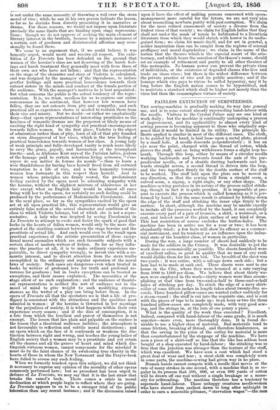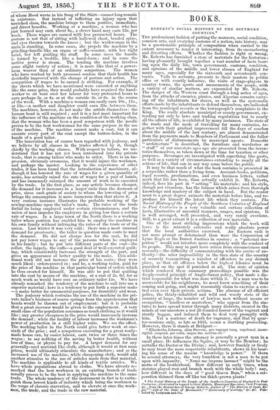PAINLESS EXTINCTION OF SEM.PSTRESSES.
TEE sewing-machine is gradually making its way into general use, and is to some extent already superseding hand-labour with the needle. Visitors to the Crystal Palace may see one kind at work daily ; but the machine is continually undergoing a process of improvement, and its applicability to almost every kind of sewing process is becoming apparent to those who originally sup- posed that it would be limited in its utility. The principle hi- therto applied is similar in most of the different eases. The cloth, to be guided by the hand, is laid loose upon a metal plate, pierced by a small hole. A needle descends perpendicularly ; it has an eye near the point, charged with one thread of cotton, which pierces the stuff, and on being withdrawn forms a slight loop be- neath. Through this loop, either by means of a circular needle working backwards and forwards round .the axis of the per- pendicular needle, or of a shuttle darting backwards and for- wards straight across, a second thread is driven into the loop, and the two together firmly tie the double surface of the stuff to be worked. The stuff laid upon the plate can be moved in any direction, so that the sewing will form a straight seam, a curved seam, a. zigzag, a right angle, or any other shape. The machine-sewing partakes in its nature of the process called stitch- ing, though in fact it is quite peculiar. It is impossible at pre- sent to execute the process which is called hemming as it is per- formed by hand • but the same result is attained by folding down the edge of the stuff and stitching the inner edge firmly to the surface. In short, although the machine may be unable exactly- to imitate all the processes worked by the hand, it can completely execute every part of a pair of trousers, a shirt, a waistcoat, or a coat, and indeed most of the plain surface of any kind of dress. This last restriction of course excludes the button-holes.. The machine has been in active use for a year or two ; it has been abundantly tried ; a few facts will show its efficacy as a commer- cial instrument, and its tendency as an influence upon the indus- trial state of the humbler class, of women in particular.
During the war, a large number of sheets had suddenly to be made for the soldiers in the Crimea. It was desirable to get the work done as economically, as possible. The sheets furnished were of excellent calico, so good in quality that no man of any rank would dislike them for his own bed. The breadth of the sheet was two yards ; it was entire, with a selvage down each side ; but a hem had to be made at each end. These sheets were sent to one house in the City, where they were hemmed at a rate varying from 1000 to 1500 per diem. We believe that about thirty wo- men were employed in the work—thirty women were thus accom- plishing at that time from two-and-a-half to three-and-a-half miles of stitching per day. To stitch the edge of a navy shirt- collar of some fifteen. inches in length takes about twenty-five se- conds. Three hundred pillow-cases are wanted rather suddenly for a steam-vessel : the stuff is cut into the requisite size and is sent with the pieces of tape to be made up ; in.an hour or two the three hundred pillow-cases are completely made, with very good sew- ing, and the strings in, at the rate of one penny a piece. What is the quality of the work thus executed.? Excellent Indeed, compared with hand-labour of the same grade, it is much superior—more even, more thoroughly done. It is found de- sirable to use a higher class of material. Bad materials tend to cause friction, breaking of thread, and therefore hinderances, so that the saving in the price of the outlay for material is more than counterbalanced by the stoppage of the machine. We have seen a piece of a shirt-cuff so fine that the like has seldom been bought at a shop executed by hand-labour ; the stitching was so firm that the junction was stronger than the texture of the stuff, which was excellent. We have seen a coat which had stood a great deal of wear and tear ; a stout cloth was completely worn in some parts, the machine-sewing had given way in no place.
Human hands cannot compete with a needle that moves at the rate of many strokes in one second, with a machine that is so re- gular in its process that 500,. 600, or even 900 yards of cotton will be drawn off one reel without a single breakage or a neces- sity for rethreading. The machine therefore has a tendency to supersede hand-labour. Those unhappy creatures needlewomen who have slaved from earliest dawn to long after midnight in order to earn a miserable pittance, " starvation wages"—the meet
of whom Hood. wrote in his Song of the Shirt—cannot long remain in existence. But instead of inflicting an injury upon that wretched class, the machine brings to them positive, immediate, and direct benefits. Working at a machine, a woman who has just learned-may earn about Ss., a clever hand may earn 12s. per week. These wages are earned with less protracted hours. The posture is not that of sitting with hollowed chest, beaded spine, and eyes thrown towards the knees ; but the workwoman in the Main is standing. In some cases, she propels the machine by a grinding-handle like an organ or coffee-roaster, with her right hand, her left guiding the stuff. In some cases the handle is turned by a treddle, like a hand-loom ; and in some the motive power is steam. The tending the machine involves some slight variety of action ; it is more like that of a power- loom weaver than of an ordinary sempstress. The women who have worked by both processes confess that their health has decidedly improved with the change of posture and action. The comparison of wages to be earned is striking. For example, if the sheets which we have mentioned were executed at anything like the same price, they would probably have required the hand- worker to sit bent over her labour for very protracted hours to earn perhaps 3s. or 4s. or at the outside 5s. or 6s. in the course of the week. With a machine a woman can easily earn 108., lls., or 12s.—a mother and daughter could earn 23s. between them. The machines, however, do not make the article themselves : the human head is still required ; and it is a fact most important for the influence of the machine on the condition of the working class, that the woman who has been a good sempstress with the needle proves to be the best workwoman for the same purpose in the use of the machine. The machine cannot make a coat, but it can execute every part of the coat except the button-holes, in the hands of a good tailor. The innovation has of course been regarded with jealousy, and we believe by all classes in the trades affected by it, though chiefly by the working classes. With respect to tailors, we un- derstand that it has not yet been introduced into the private trade, that is among tailors who make to order. There is an im- pression, obviously erroneous, that it would injure the workmen, and perhaps the master. Looking to the experience of other trades, it has been found that the introduction of machinery, al- though it has lowered the rate of wages for a given quantity of make, has actually raised the rate of wages for a pair of hands, and has immensely enlarged the amount of work to be executed by the trade. In the first place, as any article becomes cheaper, the demand for it increases in a larger ratio than the decrease of price, since each grade of society to whom the lowering of price brings the consumption is more numerous than that above it. A very curious instance illustrates the probable working of the sewing-machine upon the tailor's trade. The rules of the trade forbid its being employed under certain circumstances, and the union of men impedes the employers in giving less than a certain rate of wages. In a large town of the North there is a working tailor whose positionhas enabled him to employ the machine in his own family without infringing the rules of the trade or of the union. Last winter it was very cold ; there was a most unusual demand for greatcoats ; the tailor in question made coats to meet the demand. He did. not charge less for the coat, he did not pay lower wages to any of the persons whom he employed in his family ; but he put into different parts of the coat—the collar, the lappels, the cuffs—a good deal of well-executed quilt- ing, which considerably increases the - strength of the part, and gives an appearance of better quality to the make. This addi- tional work did not increase the price of his coats ; they were much liked ; orders poured in ; and he, a working tailor, paid for the price of his machine in that particular burst of orders which he thus created for himself. He was able to put that quilting into the coat by means of the machine, at a cost of 2s. 6d. for as much work as would have cost an ordinary tailor 15s. We have already remarked the tendency of the machine to call into use a superior material.; here is a tendency to put forth a superior make —a make better for ornamental purposes, for durability and wear.
The :jealousy which restrains the use of the machine in thepri- vate tailor's business of course springs from the apprehension that hands would be thrown out of employment: but it is probable that a great increase would be given to the employment. A very small class of the population consumes as much clothing as it would like ; any greater cheapness in the price would immensely increase the demand ; while the facility of labour increases the workman's power of production in a still higher ratio. We see the effect. The working tailor in the North could give better work at one- sixth of the price ; and a sempstress executing for a great ready- made house can, by easier labour, earn twice or three times the wages ; to say nothing of the saving by better health, without loss of time, or physic to pay for. A larger demand for any generally-used material like cloth, although it would at first raise prices, would ultimately stimulate the manufacture ; and so the increased use of the machine, while cheapening cloth, would add another stimulus to the use of articles made from that material. The machine is applicable to all kinds of textile articles. We have whole populations abroad to clothe. We have already re- marked that the best workmen in an existing branch of trade usually proves to be the best in applying the machine to the same trade. The whole tendency of the instrument in fact is to extin- guish those lowest kind's of industry which bring the workmen to the .verge of chronic starvation, and to elevate at once the work- men, the trade, and the trade in the raw material.



























 Previous page
Previous page